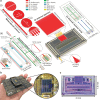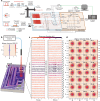An on-chip phased array for non-classical light
- PMID: 40730837
- PMCID: PMC12307807
- DOI: 10.1038/s41467-025-61886-9
An on-chip phased array for non-classical light
Abstract
Quantum science and technology can offer fundamental enhancements in sensing, communications and computing. The expansion from wired to wireless links is an exciting prospect for quantum technologies. For classical technologies, the advent of phased arrays enabled directional and adaptive wireless links by manipulating electromagnetic waves over free space. Here we demonstrate a phased array system on a chip that can receive, image and manipulate non-classical light over free space. We use an integrated photonic-electronic system with more than 1000 functional components on-chip to detect squeezed light. By integrating an array of 32 sub-wavelength engineered metamaterial antennas, we demonstrate a direct free-space-to-chip interface for reconfigurable quantum links. On the same chip, we implement a large-scale array of quantum-limited coherent receivers that can resolve non-classical signals simultaneously across 32 channels. With coherent readout and manipulation of these signals, we demonstrate 32-pixel imaging and spatially configurable reception of squeezed light over free space. Our work advances wireless quantum technologies that could enable practical applications in quantum communications and sensing.
© 2025. The Author(s).
Conflict of interest statement
Competing interests: V.G., S.I.D., A.H. and M.S. have filed a patent application (Quantum phased arrays, US patent application US 63/457,727; April 6, 2023). The remaining authors declare no competing interests.
Figures





References
-
- Ladd, T. D. et al. Quantum computers. Nature464, 45–53 (2010). - PubMed
-
- Wehner, S., Elkouss, D. & Hanson, R. Quantum internet: a vision for the road ahead. Science362, eaam9288 (2018). - PubMed
-
- Degen, C. L., Reinhard, F. & Cappellaro, P. Quantum sensing. Rev. Mod. Phys.89, 035002 (2017).
-
- Pelucchi, E. et al. The potential and global outlook of integrated photonics for quantum technologies. Nat. Rev. Phys.4, 194–208 (2022).
-
- Wang, J., Sciarrino, F., Laing, A. & Thompson, M. G. Integrated photonic quantum technologies. Nat. Photonics14, 273–284 (2020).
Grants and funding
LinkOut - more resources
Full Text Sources

